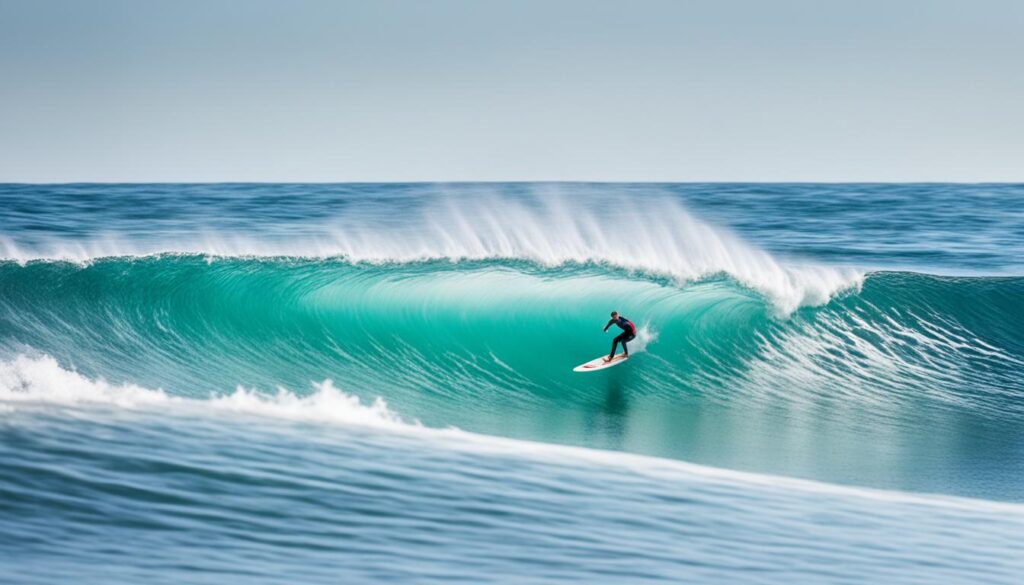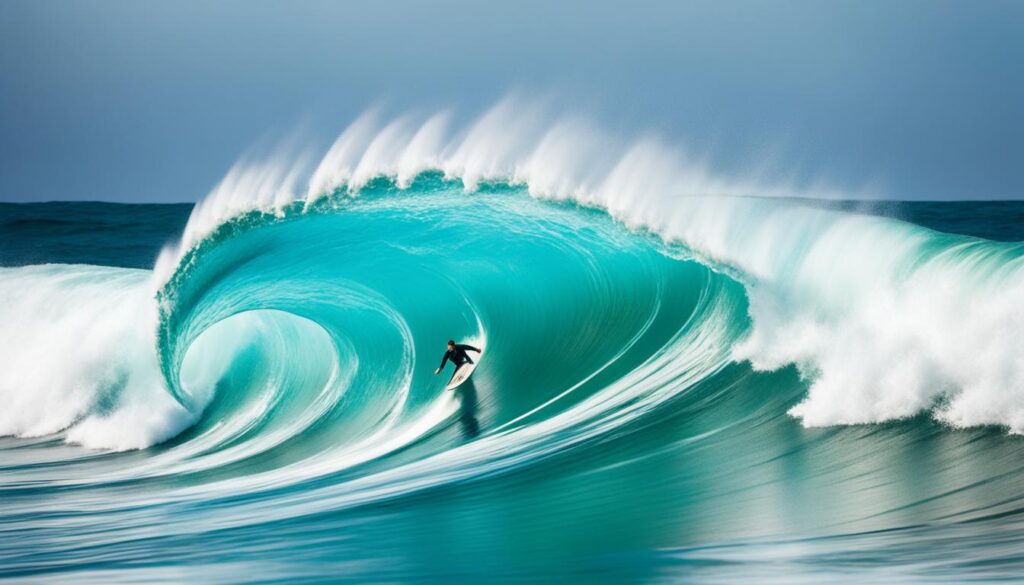Have you ever wondered why surfboards have fins? What is their purpose and how do they contribute to a surfer’s performance on the waves? Whether you’re a beginner or an experienced surfer, understanding the importance of surfboard fins is crucial to achieving the ultimate wave riding experience.
Key Takeaways:
- Surfboard fins are essential for a surfer’s success on the waves.
- Choosing the right fins for your surfboard can greatly enhance your wave riding experience.
- There are different types of surfboard fins, including glassed-in and swappable fins.
- Fin configurations and dimensions play a significant role in the performance of your surfboard.
- The materials and construction of surfboard fins impact their stiffness, flex, and overall feel.
Understanding the Difference Between Glassed-in and Swappable Fins
When it comes to surfboard fins, there are two main types: glassed-in fins and swappable fins. Each type offers its own unique advantages and considerations. Let’s take a closer look at the differences between these two fin options.
Glassed-in Fins
Glassed-in fins, also known as fixed or permanent fins, are integrated into the surfboard during the construction process. They are laminated into the board using fiberglass, providing a seamless and durable connection.
One of the primary benefits of glassed-in fins is the solid and smooth feel they offer. Since they are part of the board’s structure, they provide a consistent and reliable performance, especially in powerful waves.
However, it’s important to note that glassed-in fins are more challenging to repair if they get damaged. Unlike swappable fins, these fins cannot be easily removed or replaced. So, if you happen to break or lose a glassed-in fin, it may require professional repair or even board replacement.
Swappable Fins
Swappable fins, also known as removable fins, are a popular choice among surfers due to their versatility and ease of use. These fins are installed using a fin box system, which allows for quick installation, removal, and replacement.
Different brands provide various fin box systems, such as FCS (Fin Control System) and Futures. The installation process typically involves using a specialized fin key to secure the fins in place.
Swappable fins offer several advantages over glassed-in fins. Firstly, they provide more flexibility, as you can easily experiment with different fin setups to suit different wave conditions and riding preferences. Secondly, if a fin gets damaged or broken, you can replace it without having to repair the entire board.
However, it’s important to handle your fin box with care to avoid any damage to your surfboard. Accidental impact or mishandling of the fins can cause the fin boxes to become loose or even break, compromising the stability and performance of your board.
| Factors | Glassed-in Fins | Swappable Fins |
|---|---|---|
| Installation | Laminated into the board during construction | Installed using a fin box system |
| Repair | Difficult to repair, may require professional intervention or board replacement | Easy to replace damaged or broken fins |
| Versatility | Less versatile, fin configuration cannot be easily changed | Offers flexibility to experiment with different fin setups |
| Performance | Provides a solid and consistent performance | Allows for customization based on wave conditions and riding preferences |
| Repair | Challenging to repair | Easy to replace damaged or broken fins |
Understanding the difference between glassed-in and swappable fins is essential in choosing the right fin setup for your surfboard. Whether you prioritize stability and durability or versatility and customization, make sure to consider your riding style, skill level, and wave conditions when selecting the perfect fins for your surfboard.
Choosing the Right Fins for Your Surfboard
Choosing the right surfboard fins is crucial for enhancing your wave riding experience. Whether you’re a beginner or an experienced surfer, selecting the appropriate fins can greatly impact your performance on the waves. Here are key factors to consider when choosing the best surfboard fins for your needs.
1. Body Weight and Fin Size
Your body weight plays a significant role in determining the appropriate fin size for your surfboard. Using a size chart specifically designed for surfboard fins, identify the recommended size range based on your weight. This will ensure optimal performance and control when riding the waves.
2. Fin Configuration
Consider the fin configuration of your surfboard, as it greatly affects the board’s performance characteristics. There are various fin configurations to choose from, including:
- Single: Provide stability, control, and predictability. Ideal for longboards.
- Twin: Offer a playful and maneuverable feel, suited for smaller waves.
- Thruster: The most commonly used configuration with three fins. Offers control, stability, and versatility for surfers of all levels.
- Quad: Excel in smaller surf, providing speed and stability.
- 5-Fin System: Allow flexibility to experiment with different setups based on the surf conditions.
Choose a configuration that aligns with your preferred riding style and the type of waves you typically encounter.
3. Fin Dimensions and Geometry
The dimensions and geometry of your surfboard fins also play a vital role in their performance. Consider the following measurements:
- Sweep: The fin’s curve determines the turning radius.
- Toe: The angle of the fins towards the stringer enhances responsiveness and grip.
- Base Length: Affects drive and turning ability.
- Foil: Shapes water flow over the fin surface, impacting speed and control.
- Flex: Determines the amount of flex in the fin, influencing responsiveness.
- Height: The overall height of the fin affects stability and control.
- Cant: The outward angle of the fin impacts responsiveness.
Take these measurements into account to customize your surfboard’s performance and responsiveness based on your preferences.
4. Best Surfboard Fin for Beginners
If you’re a beginner, it’s recommended to start with a thruster configuration and medium-sized fins. This setup offers a balance of stability, control, and maneuverability, making it easier for beginners to learn and progress their skills on the waves.
Surfboard Fin Setup Guide
| Surfboard Type | Recommended Fin Setup |
|---|---|
| Shortboard | Thruster (3 fins) |
| Longboard | Single fin |
| Fish Board | Twin or Quad |
| Hybrid | 5-Fin System |
Keep in mind that these recommendations are general guidelines, and personal preferences may vary. Experimenting with different fin setups can help you find the perfect configuration for your unique surfing style.
Exploring Fin Configurations and Their Benefits
Different fin configurations offer unique benefits for various surfing styles and wave conditions. Let’s take a closer look at some popular fin configurations:
Single Fin
The single fin configuration is commonly found on longboards. It provides excellent stability, control, and predictability, making it a favorite choice for classic wave riding.
Twin Fin
If you’re looking for a playful and maneuverable feel, twin fins are the way to go. This configuration consists of two fins and is ideal for smaller waves. It offers a looser and more lively ride.
Thruster Fin
The thruster fin setup is arguably the most commonly used configuration in the surfing world. It features three fins – a center fin and two side fins. Thruster fins provide a perfect balance of control, stability, and versatility for surfers of all levels. This setup offers excellent performance in a wide range of wave conditions.
Quad Fin
If you enjoy surfing smaller waves, quad fins are worth considering. This configuration consists of four fins and excels in generating speed and providing stability. Quad fins offer a more responsive and looser feel compared to the thruster setup.
5-Fin System
The 5-fin system provides the utmost flexibility for surfers. It allows you to experiment with different setups depending on the surf conditions. This configuration combines the thruster and quad setups, giving you the option to ride with either the thruster or quad fins, or even use a combination of both for a customized experience.
Each fin configuration offers unique advantages, allowing surfers to tailor their boards to their preferences and the conditions they encounter. Whether you prefer stability, maneuverability, speed, or versatility, there is a fin configuration suited to your style.
In the next section, we will explore the importance of fin dimensions and geometry and how they impact your surfing performance.
Understanding the Importance of Fin Dimensions and Geometry
To fully maximize the performance of your surfboard fins, it’s crucial to consider their dimensions and geometry. By understanding key factors such as fin rake, fin foil, fin cant, and fin toe, you can enhance your wave riding experience and achieve optimal control and maneuverability on the water.
Fin Dimensions
Fin dimensions play a critical role in determining how your board rides and turns. These dimensions include:
- Fin Rake: The rake of a fin refers to the angle at which it sweeps back. It influences the arc of the fin and directly affects the turning radius of your board. Fins with more rake offer smoother, drawn-out turns, while fins with less rake provide tighter, more responsive turns.
- Fin Foil: The foil of a fin shapes the water flow over its surface, impacting both speed and control. Fins with different foil designs create varying levels of lift and drag, allowing you to optimize your performance based on the wave conditions and your preferred riding style.
- Fin Cant: Fin cant refers to the outward angle of the fin in relation to the base. It influences how the board responds to your movements, enhancing responsiveness and ensuring optimal performance. Fin cant can be adjusted depending on your preferences and the wave conditions you encounter.
- Fin Toe: Fin toe refers to the angle at which the fins are aligned towards the stringer. By adjusting the toe angle, you can fine-tune the responsiveness and grip of your board, allowing for greater control and stability in various wave conditions.
By carefully considering these fin dimensions, you can tailor your setup to suit your surfing style, the characteristics of the waves you ride, and your personal preferences.
| Fin Dimension | Impact |
|---|---|
| Fin Rake | Influences turning radius |
| Fin Foil | Affects speed and control |
| Fin Cant | Enhances responsiveness |
| Fin Toe | Improves grip and maneuverability |
Remember, experimenting with different fin setups is key to finding the perfect configuration for your surfboard. By understanding and fine-tuning the dimensions and geometry of your fins, you can unlock the full potential of your board and enjoy an incredible wave riding experience.

Exploring Materials and Construction in Surfboard Fins
When it comes to surfboard fins, the materials and construction used greatly impact their performance in the water. Fins can be made from a variety of materials, including fiberglass, composite materials, G10, and performance core materials. Each material offers its own unique characteristics, influencing the stiffness, flex, and overall feel of the fin.
Fiberglass fins are a popular choice among surfers for their durability and versatility. They provide a good balance between flex and stability, making them suitable for a wide range of surfing conditions. Composite fins, on the other hand, are made by combining different materials to achieve specific performance characteristics. These fins are known for their high performance and responsiveness, perfect for experienced surfers looking to push their limits.
G10 fins, made from a high-grade fiberglass material, are renowned for their exceptional strength and rigidity. These fins are ideal for surfers who prefer a stiffer fin with maximum control and stability. In contrast, performance core fins are constructed using lightweight materials, such as foam or honeycomb, for enhanced maneuverability and responsiveness. These fins are often favored by competitive surfers who require quick turns and explosive maneuvers.
When selecting the right fin material for your surfboard, it’s essential to consider your surfing style, wave conditions, and personal preferences. Experimenting with different materials can help you find the perfect balance of flexibility, stiffness, and control that suits your needs. The right choice of fin material can significantly enhance your wave riding experience, allowing you to push your limits and perform at your best.

